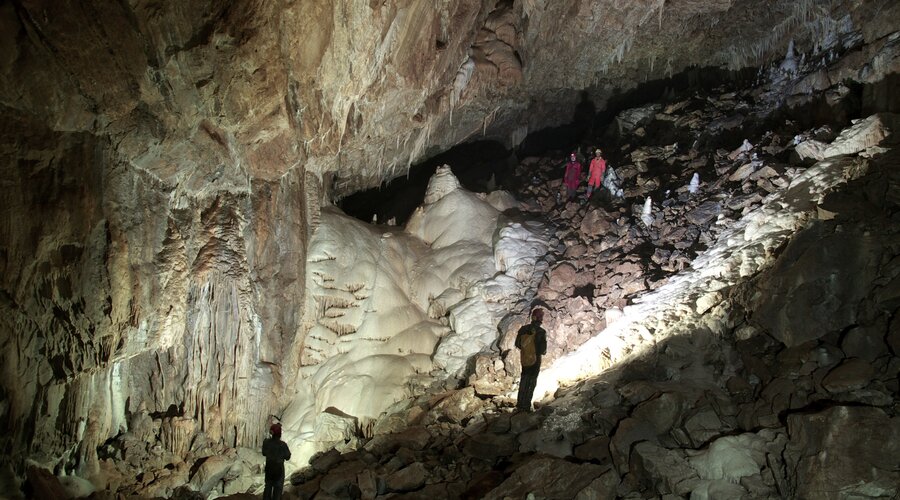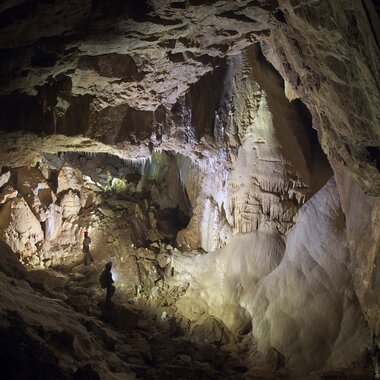Construction of a new tourist route in the so-called ‘Mastodon Parts’ has started - KGHM CUPRUM is involved in work in the Bear Cave
In the part of the Bear Cave in Kletno that was discovered several years ago, work has begun on opening the so-called ‘Mastodon Part’ to tourists. The conceptual and design work for the adaptation of this part of the Cave to use by tourists is being carried out by KGHM CUPRUM, a company that has for many years been involved in work on opening various types of underground structures to the public - both post-mining ones (Wieliczka Salt Mine, St. John Mine - Geopark in Krobnica) and ones of natural origin.
The underground tourist route currently in operation in the Bear Cave is the result of work by the Copper Research and Design Company 'CUPRUM' carried out in the 1970s. The new route, which is currently being prepared, is also the result of a concept and design prepared by the KGHM CUPRUM Research and Development Centre.
The preparation of the route in the Mastodon Part is the largest investment in the history of the Stronie Śląskie municipality - with the municipality's annual budget at PLN 50 million, the preparation of the route will cost PLN 38 million, and the scope and level of complexity of the works is several times higher than that of the municipality's largest investment to date, which was the construction of a tower on the Śnieżnik mountain.
Particularly challenging for the design and performance of the works are the environmental constraints arising from the unique nature of the Cave and its surroundings, with unique natural values that require absolute protection, during both the construction of the new tourist route and its use.
The development of solutions that meet such specific requirements, initially considered infeasible by the Regional Directorate for Environmental Protection, is the work of KGHM CUPRUM. Through its participation in this project, KGHM CUPRUM is pursuing its mission based on its status as a research and development centre. The new route will be made available not only to tourists, but also to researchers and scientists who do not currently have the technical capacity to conduct interdisciplinary research in this unique environment.
‘It is safe to say that KGHM CUPRUM has played a key role in the activities to date aimed at making the newly-discovered parts of the Cave accessible to tourists, in particular by developing a concept of technical solutions that meet the strict environmental protection requirements of the facility and its surroundings’, says Dr. Maciej Madziarz, under whose direction the concept was developed at the Mining Department of KGHM CUPRUM.
The feasibility study assumes that the new tourist route will be completed in about four years. Visitors will be offered another unusual attraction in the Bear Cave: a brand-new second route of about 850 metres, which will take about an hour to complete. Its most interesting part is the Mastodon Hall, whose dimensions are similar to the pitch of the National Stadium in Warsaw. It should be noted that the character of the new underground route will be completely different from that of the existing cave: visitors will certainly be impressed by the huge size of the underground cavities and the exceptionally rich flowstone cover. In addition, tourists will also navigate multiple levels, rather than just one level of cave passages as they did before.
The Bear Cave in Kletno - referred to as the Pearl of the Polish Sudetes - is a site of great environmental value and unquestionable tourist potential. It was discovered in 1966 and opened to tourists on 11 June 1983. Its opening was preceded by eight years of design, mining and construction work, in which the then CUPRUM Copper Research and Design Company played an essential role.
The current involvement of KGHM CUPRUM in the design work is therefore a natural continuation of the activities of KGHM CUPRUM in the area of research and design work in the Bear Cave in the Sudetes, and will result in the dissemination and popularisation of the tourist and educational qualities of this unique work of nature in our country.
photo Szymon Kostka







